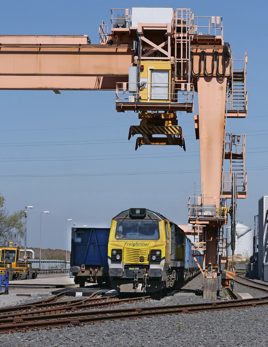“We need people in rail freight who understand what is required by the supply chain,” says Worth.
“Logisticians talk a different language - about product lines, roll cages and pallets, not containers and trains. Bilingual professionals can work with aggregators like W H Malcolm and Russell Logistics on Anglo-Scottish traffic and Maritime Transport to fill multi-customer services.
“This is vital, since no more than a quarter to a third of freight trains are likely to be trainload from a single customer. It’s a great asset to have experience across the industry, someone like Jess Lippett who has worked for DB Cargo, Tarmac and is now a Senior Route Freight Manager at NR.”
In Scotland, a catalyst for attitudinal change in rail freight was the introduction in 2017 of modal shift targets and the requirement for NR to apply “all levers at its disposal to make the use of rail freight attractive to business across Scotland”.
Says Reeve: “Targets end the attitude of some managers that they had no role in promoting rail freight. Marking score cards on success in introducing new freight ensures senior-level discussions and affects investment decisions.
“It has concentrated minds and changed behaviour. You have to be cleverer than saying ‘you must run more tonne/miles’ because organic growth may happen. The object is to attract new business such as Highland Spring with its new rail connection at Blackford. Creating a climate in which people are excited by the prospect of winning new rail freight traffic is a necessary condition for success.”
The High Level Output Specification requires “all reasonable steps to be taken to facilitate growth of 7.5% in rail freight traffic carried on the Scotland route, of which at least 7.5% will represent a growth in new business (new traffic flows, not previously moving by rail)”.
The DfT has promised modal shift targets for NR in England and Wales in Decarbonising Transport, but details are unknown.
NR’s Richard Moody believes we should align the new targets for England and Wales with Scotland, to avoid disparities. He echoes Bill Reeve in seeing them as a game-changer, with GBR hopefully emulating the joined-up approach between NR, Transport Scotland and ScotRail in meeting targets most efficiently.
Because of the potential for long distances, services through the Channel Tunnel can make a substantial contribution to carbon reduction. DB Cargo’s new automotive service reaching the Czech Republic will carry 230 cars in each direction, removing 46 road transporter journeys.
Driver shortages on the continent are as serious as in the UK, and Guy Bates thinks it’s high time we addressed the gauging handicaps of the classic route from Dollands Moor (near Dover) to Wembley.
“We are essentially still stuck in the early 1990s, which excludes most of the market. S44 swap bodies will fit within the loading gauge, but we cannot accommodate S45s. When you round up an imperial 9ft 6in high swap body to centimetres and millimetres, it comes out plated as an S45, though empirical evidence suggests that actually they are slightly smaller and should fit.
“Nonetheless, there is a need to at least do some incremental gauging work to allow S45s formally to use the route. That would usefully broaden the addressable market for rail and push open the door for new Channel Tunnel intermodal traffic.”
Julian Worth adds: “The use of HS1 to Barking for freight would also be highly beneficial, enabling use of the massive continental-gauge intermodal wagon fleet. A simple lift onto UK-gauge wagons at Barking would enable swap bodies to move forward to the Midlands, the North, Wales and Scotland.”












